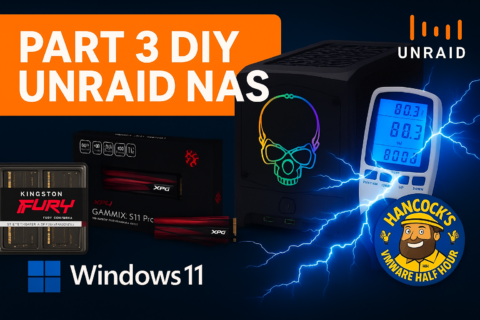PART 3 – DIY Unraid NAS: Power Testing & Stability Checking with OCCT
Welcome back to Part 3 of the DIY Unraid NAS series!
In Part 1, we unboxed and assembled the hardware.
In Part 2, we ran a quick Windows 11 installation test (and of course, everything that could go wrong… went Pete Tong).
Now that the system boots and behaves under a “normal” workload, it’s time to get serious. Before committing this Intel NUC–powered machine to Unraid full-time, we need to ensure it’s electrically stable, thermally stable, and capable of running 24/7 without surprises.
This stage is all about power draw, thermals, and stress testing using OCCT — a powerful tool for validating hardware stability.
Why Power & Stability Testing Is Essential for a NAS
A NAS must be:
- Reliable
- Predictable
- Stable under load
- Able to handle long uptimes
- Capable of sustained read/write operations
- Tolerant of temperature variation
Unlike a desktop, a NAS doesn’t get breaks. It runs constantly, serving files, running Docker containers, hosting VMs, and performing parity checks. Any weakness now — PSU spikes, hot VRMs, faulty RAM — will eventually show up as file corruption or unexpected reboots.
That’s why stress testing at this stage is non-negotiable.
Using OCCT for a Full-System Torture Test
OCCT is typically used by overclockers, but it’s perfect for checking new NAS hardware.
It includes tests for:
1. CPU Stability
Pushes the CPU to 100% sustained load.
Checks:
- Thermal throttling
- Cooling capacity
- Voltage stability
- Clock behaviour under load
A NAS must not throttle or overheat under parity checks or rebuilds.
2. Memory Integrity Test
RAM is the most overlooked component in DIY NAS builds.
Errors = silent data corruption.
OCCT’s memory test:
- Fills RAM with patterns
- Reads, writes, and verifies
- Detects bit-flip issues
- Ensures stability under pressure
Memory integrity is vital for Unraid, especially with Docker and VMs.
3. Power Supply Stress Test
OCCT is one of the few tools capable of stressing:
- CPU
- GPU (if present)
- Memory
- All power rails
simultaneously.
This simulates worst-case load and reveals:
- Weak PSUs
- Voltage drops
- Instability
- Flaky power bricks
- VRM overheating
Not what you want in a NAS.
4. Thermal Behaviour Monitoring
OCCT provides excellent graphs showing:
- Heat buildup
- Fan curve response
- Temperature equilibrium
- VRM load
- Stability over time
This shows whether the NUC case and cooling can handle long running services.
Test Results: Can the Intel NUC Handle It?
After running OCCT, the system performed exceptionally well.
CPU
- No throttling
- Temperatures within acceptable limits
- Clock speeds held steady
RAM
- Passed memory integrity tests
- No bit errors
- Stable under extended load
Power Delivery
- No shutdowns or brown-outs
- The power brick handled peaks
- VRMs stayed within thermal limits
Thermals
- Fans behaved predictably
- Temperature plateau was stable
- No unsafe spikes
In other words:
This machine is ready to become an Unraid NAS.
Why Validate Hardware Before Installing Unraid?
Because fixing hardware problems AFTER configuring:
- Shares
- Parity
- Docker containers
- VMs
- Backups
- User data
…is painful.
Hardware validation now ensures:
- No silent RAM corruption
- No thermal issues
- No unexpected shutdowns
- No nasty surprises during parity builds
- The system is reliable for 24/7 operation
This step protects your data, your time, and your sanity.
What’s Coming in Part 4
With the hardware:
- Burned in
- Power-tested
- Thermally stable
- Verified by OCCT
We move to the exciting part:
Actually installing Unraid!
In Part 4, we will:
- Prepare the Unraid USB boot device
- Configure BIOS for NAS use
- Boot Unraid for the first time
- Create the array
- Assign drives
- Add parity
- Begin configuring shares and services
We’re finally at the point where the NAS becomes… a NAS!
Stay tuned — the best parts are still ahead.
Tags: andrewhancock, andysworld, cpu stress test, diy nas, diy unraid nas, Hancock's VMware Half Hour, hardware validation, home server, homelab, homelab setup, intel nuc, intel nuc nas, intel skull nuc, nas build, nas build 2025, nas power consumption, nas power requirements, nas stability, nas thermal testing, occt, occt stress test, pc burn in test, power supply test, ram stress test, server build, server testing, stability testing, system stability test, thermal testing, UnRAID, unraid guide, unraid hardware testing, unraid hardware tips, unraid nas, unraid series, unraid tutorial, Ventoy, VMware Half Hour
